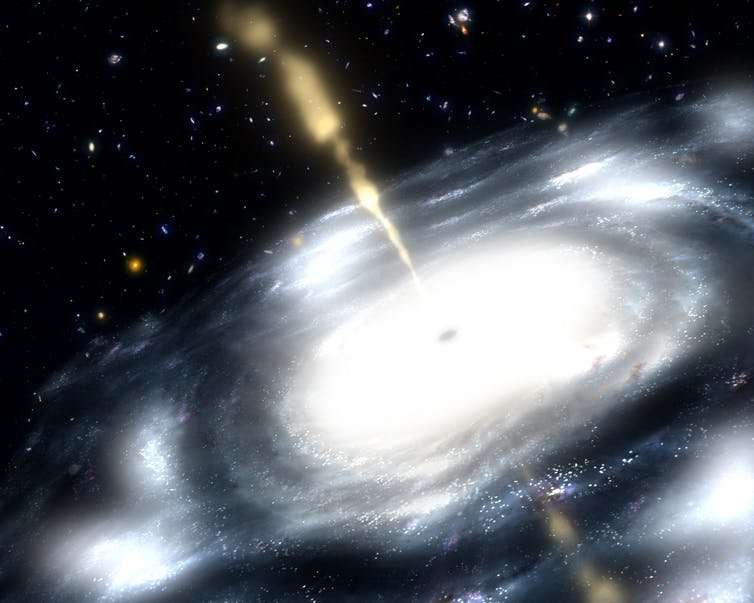How we discovered the strange physics of jets from supermassive black holes

Supermassive black holes, which lurk at the heart of most galaxies, are often described as "beasts" or "monsters". But despite this, they are pretty much invisible. To show that they are there at all, astronomers typically have to measure the speed of the clouds of gas orbiting those regions.
But these objects can sometimes make their presence felt through the creation of powerful jets, which carry so much energy that they are able to outshine all the light emitted by the stars of the host galaxy. We know that these "relativistic jets" are two streams of plasma (matter made up of electrically charged particles despite having no overall charge), travelling in opposite directions at velocities very close to the speed of light.
The physics governing these cosmic fountains, however, has long been a bit of a mystery. Now our new paper, published in Nature Astronomy, has shed some light on the causes of their extraordinary appearance.
What makes relativistic jets exceptional is their impressive stability: they emerge from a region as big as the event horizon (the point of no return) of the supermassive black hole and propagate far enough to break out from their host galaxy while maintaining their shape for a long time. This corresponds to a length that is a billion times their initial radius – to put this in perspective, imagine a water fountain coming out of a 1cm wide hose pipe and remaining undisrupted for 10,000km.
Once the jets propagate at great distances from their origin, though, they lose their coherence and develop extended structures which often resemble plumes or lobes. This indicates that the jets undergo some sort of instability, strong enough to completely change their appearance.
A jet dichotomy
The first astrophysical jet was discovered in 1918 by the American astronomer Heber Curtis, who noticed "a curious straight ray … apparently connected with the nucleus by a thin line of matter" in giant elliptical galaxy M87.

In the 1970s, two astronomers at the University of Cambridge, Bernie Fanaroff and Julia Riley, studied a large ensemble of jets. They found that they could be split into two classes: those containing jets whose brightness decreases with distance from their origin, and those that become brighter at their edges. Overall, the latter type is about 100 times more luminous than the former. They both have slightly different shape at the end – the first is like a flaring plume and the second resembles a thin turbulent stream. Exactly why there are two different kinds of jets is still an area of active research.
As jet material gets accelerated by the black hole, it reaches velocities up to 99.9% of the speed of light. When an object moves so fast, time dilates – in other words, the flow of time at the jet, measured by an external observer slows down as predicted by Einstein's special relativity. Because of this, it takes longer for the different parts of the jet to communicate with each other – as in interacting or influencing each other – while travelling away from their source. This, effectively, protects the jet from being disrupted.
However, this loss of communication does not last forever. When the jet is ejected from the black hole, it expands sideways. This expansion makes the pressure inside the jet drop, while the pressure of the gas surrounding the jet does not decrease as much. Eventually, the external gas pressure overtakes the pressure inside the jet and makes the flow contract by squeezing it. At this point, the parts of the jet come so close that they can communicate again. If some parts of the jet have become unstable in the meantime, they can now exchange this information and instabilities can spread to affect the entire beam.
The process of expansion and contraction of the jets has another important consequence: the flow is no longer along straight lines but on curved paths. Curved flows are likely to suffer from "centrifugal instability" which means they start creating whirlpool-like structures called vortices. This was not considered to be critical for astrophysical jets until recently.
Indeed, our detailed computer simulations show that relativistic jets become unstable because of the centrifugal instability, which initially only affects their interface with the galactic gas. Once they have contracted due to external pressure though, this instability spreads throughout the entire jet. The instability is so catastrophic that the jet does not survive beyond this point and gives place to a turbulent plume.
Putting this result in perspective we get a better insight of the impressive stability of astrophysical jets. It can also help explain the enigmatic two classes of jets discovered by Fanaroff and Riley – it all depends on how far from its galaxy a jet becomes unstable. We made computer simulations of what these jets would look like based on our new understanding of the physics of these cosmic beams, and they very much resemble the two classes we see in astronomical observations.
There's a lot more to learn about the gigantic, wild beasts residing at the centre of galaxies. But little by little, we are unravelling their mystery and showing that they are indeed perfectly law-abiding and predictable.
Journal information: Nature Astronomy
Provided by The Conversation
This article was originally published on The Conversation. Read the original article.![]()





















